What is Plywood?
Plywood is a type of composite wood. It’s made using wood veneers taken from hardwoods, softwoods, and other types of trees. Although higher-grade plywood is pressed and heated in more complicated ways, these wood veneers are usually bonded together.
Since plywood has more sturdy surfaces than 24 logs, it is preferable. It is because plywood does not expand when moisture is applied across the board’s grain. Aside from that, plywood is resistant to cracking, shrinking, breaking, and warping due to the procedures it goes through. It’s usually placed in furniture like cabinets, cupboards, television units, dressing tables, center tables, dining tables, and in building projects like bracing, panels, and ornamental objects.
Types of Plywood:
There are many different kinds of plywood in the market. They’re chosen depending on their specific use and many features.
1. Softwood Plywood:
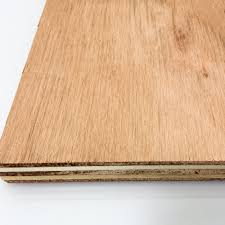
Fig 1: Softwood Plywood
Courtesy: cutmyplastic.co.uk
Softwood plywood has a softwood face and back veneer rather than a hardwood veneer such as Birch, Maple, or Oak. Softwood plywood panels have a core made of either softwood or hardwood and are faced and backed with a softwood veneer. They are utilized for structural applications.
Softwoods plywood are used for construction subfloors, exterior side frame sheathing, roof sheathing, dog house, and shelves, as well as packages, parking or garden fencing, and boxes.
2. Hardwood Plywood:
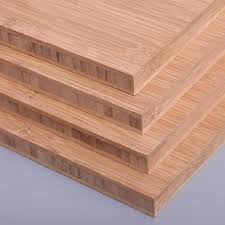
Fig 2: Hardwood Plywood
Courtesy: exportersindia.com
Hardwood Plywood has a hardwood face and back veneer rather than a softwood veneer such as pine, cedar, or spruce. Hardwood plywood panels are composed of a softwood or hardwood core that is faced and backed with a finish or stain-grade hardwood veneer. They can make furniture, cabinets, millwork, and other decorative items.
3. Structural Plywood:
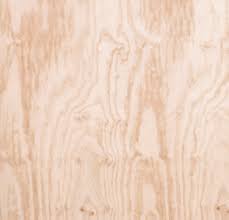
Fig 3: Structural Plywood
Courtesy: forest1.com
It is also known as sheathing plywood for its recognized longevity in framing and construction. In the production of structural plywood, the most robust and most waterproof glues are employed. They are usually given a C or D grade. And, despite their exceptional durability, they cannot be graded higher since the building would become prohibitively expensive.
When it comes to adverse weather conditions, structural plywood, on the other hand, is not very adaptable. Nonetheless, they remain the most popular woodworking materials for indoor and outdoor projects. This plywood is ideal for the subfloor, internal constructions, roof bracing, wall bracing, and beams.
4. Exterior Plywood:
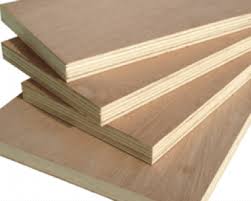
Fig 4: Exterior Plywood
Courtesy: thedesignbridge.in
Exterior plywood sheets are classified as multi-ply because they often have numerous veneers glued together. Depending on where you reside, you can choose from various wood types for external plywood. Wood-like oak, which can withstand mildew and mold from wet environments, may fare better in some regions that undergo tough seasons.
5. Aircraft Plywood:
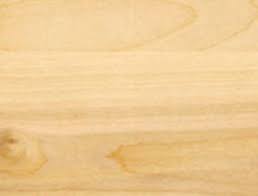
Fig 5: Aircraft Plywood
Courtesy: westwindharwood.com
Aircraft plywood is higher-grade, more robust plywood. Aircraft plywood is constructed of thinner veneers to make it more workable and lightweight and it’s made of woods like birch and mahogany. This type of plywood is moisture and heat resistant
6. Lumber Core Plywood:
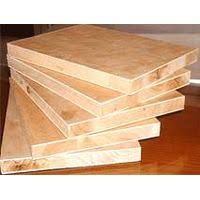
Fig 6: Lumber Core Plywood
Courtesy: ecplaza.ner
Core made of wood Plywood is often made of three sheets, each with two thin veneers on one side and a thick body. The exterior veneers are usually hardwood, while the inner core comprises strips of wood cemented together to form a solid slab.
The inner core aids in the grasping of screws, making it a fantastic choice for tasks requiring a firm screw hold. One disadvantage of poorly manufactured timber core plywood is that it may have holes in the core, limiting its strength and capacity to hold screws.
7. Marine Plywood:
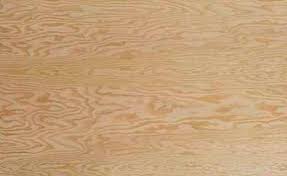
Fig 7: Marine Plywood
Courtesy: sears-trostel.com
Marine plywood is a form of plywood with resistance to delamination and fungal assault characteristics, making it even more adaptable than plywood in terms of where it may use and how long it can last.
8. Composite Plywood:
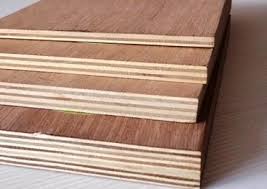
Fig 8: Composite Plywood
Courtesy: extrudesign.com
Composite plywood is identical to ordinary plywood, but it has external layers made of fiberboard covered with hardwood and an internal layer made of regular wood. Cabinets and furniture are the most common applications for composite plywood.
9. Tropical Plywood:
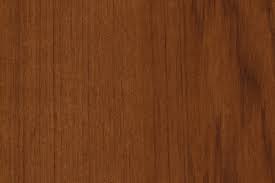
Fig 9: Tropical Plywood
Courtesy: 123rf.com
Different sorts of tropical region timbers are blended to manufacture plywood. Although it was formerly derived mainly from Asia, it is now extracted from Africa and America. Tropical plywood is renowned for its unique characteristics, such as resistance quality, thickness, inflexibility, evenness, strength, and density.
Plywood is the most often produced material in this tropical region of South Asia. Countries like Japan, Thailand, Taiwan, Seoul, Dubai, and even America employ this style. Tropical Plywood is used to make concrete panels, laminated boards, structural panels, floor bases, and container flooring, among other things.
10. Apple Plywood:
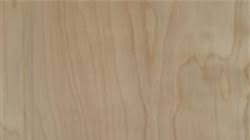
Fig 10: Apple Plywood
Courtesy: buyappleply.com
Apple plywood is high-end plywood manufactured from thin layers of birch and veneered with various species. Plywood is made out of alder and birch wood strips that are laminated together. Apple plywood is strong and lightweight, making it easier to work with and perfect for building furniture, cabinets, and ornamental items.
11. Overlaid or Decorative Plywood:
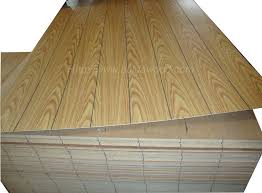
Fig 11: Overlaid Plywood
Courtesy: diytrade.com
Overlaid Plywood is made of ash, birch, maple, red oak, rosewood, oak, mahogany, and teak, with the top layer being polished with ornamental wood and referred to as decorative Plywood. The overlaid laminated Plywood not only adds a finished aesthetic but also makes the board more robust, water-resistant, scratch-resistant, and resistant to other types of damage. The outer surface is usually bonded using a heat and pressure procedure.
12. Sanded Plywood:
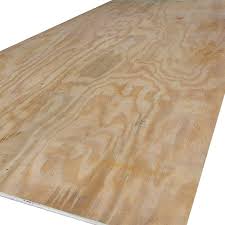
Fig 12: Sanded Plywood
Courtesy: diytrade.com
In sanded plywood, the top, bottom, and face of the piles are sanded, making them smooth and consistent. Since sanded plywood has a good finish quality and is long-lasting, it is employed for structural purposes
13. Flexible Plywood:
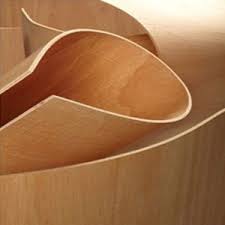
Fig 13: Flexible Plywood
Courtesy: delhitimber.com
Flexible plywood is manufactured with a core cross-grained ply and thicker cross-grained ply on both sides. Overlaid wood veneers are placed on the front surface to give it a shinier appearance. It is used to make curved parts of decor and for design purposes, and it is typically 1/8 inch or 3/8 inch thick with a 12-inch width. After getting the optimum curve, the boards are bonded in two layers to make the shape stiff or rigid and prevent movement.
14. Subfloor Plywood:
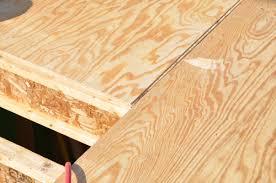
Fig 14: Subfloor Plywood
Courtesy: vinawoodltd.com
As it is where the floor finish will be applied, the subfloor is a crucial aspect of the entire construction job. Plywood subflooring is less expensive than concrete subflooring. In addition, the subfloor plywood is waterproof and typically comes in thicknesses ranging from 3/4 to 1 1/8 inches.
Grades of Plywood:
There are different grades of plywood to pick from if you’re looking for the correct type of plywood for your project. There are four main types of plywood veneer grade.
i) A-grade Plywood:
It is the highest-quality plywood and consequently the most expensive because the veneers will be excellent. A-grade plywood is smooth and can easily paint.
ii) B-grade Plywood:
B-grade plywood has a firm foundation and is slightly less smooth than A-grade plywood. However, it typically has minor defects and can be repaired.
iii) C-grade Plywood:
C-grade plywood has a few 1.5-inch-diameter knots in the sheets.
iv) D-grade Plywood:
The most affordable grade of plywood veneers, these sheets are usually undamaged. However, the faults in this type of plywood can be slightly more significant, and the knots can be up to 2.5 inches across.
Benefits of Using Plywood:
- It is convenient to use because it comes in a variety of sizes. In addition, it is simple to use nails or screws on it without causing damage to the plank.
- It is ideal for interior work since it does not shrink or warp due to temperature changes and a long lifespan.
- It is made with minimal waste in mind, and it is also recyclable and cost-effective.
Conclusion:
Plywood has been a popular wood material in the latest days, which is logical for various reasons. Aside from being a cost-effective option, the many varieties of plywood demonstrate that there may be a less expensive option for specific needs. Although plywood is not as elegant as genuine wood, you may rely on its low-maintenance quality and moisture resistance.
References:
1. 9 Different Types Of Plywood Sheets & Board (Buying Guide) – Home Stratosphere. (2021, August 5). Home Stratosphere. https://www.homestratosphere.com/types-of-plywood/.
2. Types of Plywood. (n.d.). The Home Depot. https://www.homedepot.com/c/ab/types-of-plywood/9ba683603be9fa5395fab909d37f448.
3. Types of Plywood – This Old House. (2020, August 14). This Old House. https://www.thisoldhouse.com/woodworking/21368970/types-of-plywood.
4. Different Grades, Sizes, and Types of Plywood. (2021, December 20). Unhappy Hipsters. https://unhappyhipsters.com/types-of-plywood/.
5. Legros, S. (2018, November 29). What Are the Different Grades Of Plywood? -. What Are the Different Grades of Plywood? -. https://forestplywood.com/blog/about-plywood/what-are-the-different-grades-of-plywood/.
6. Timber, T., & W. (2019, June 18). The Different Types of Plywood | Theo’s Timber Ltd. Theos Timber. https://noyekplywood.co.uk/types-of-plywood/.
If you have a query, you can ask a question here.


